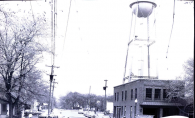When asked how they first become interested in studying weather, many meteorologists cite a major childhood event, such as a tornado or hurricane. But White Bear Lake’s (unofficial) resident meteorologist, 54-year old Frank Watson, was born into the business.
Watson’s first weather-related memory dates back to age 4 or 5, when he would use crayons to color weather maps at his father Bruce’s office in Virginia Beach, Va. The Watson family moved to the Twin Cities in 1966, where Bruce worked for Honeywell. The following year, Frank Watson and his older brother, Bruce, spent the summer helping their father with a cloud-monitoring project (using time-lapse photography) in Colorado Springs, Colo.
Watson really got hooked on the idea of a career in meteorology in 1975 when he helped his father on a research project to assess the possible impact of copper-nickel mining in the Boundary Waters Canoe Area. “I thought, ‘This is a great deal; you’re working outdoors; you’re not stuck in an office behind a desk!’”
Watson went on to earn a Bachelor of Arts degree in atmospheric science at the University of Wisconsin–Madison. After his junior year, he spent the summer of 1982 working at KARE–11 as a weather producer, generating graphics and forecasts. He spent the next decade at KARE working with weathermen Joe D’Andrea, Barry Zevan and then Paul Douglas.
In the early 1990s, Watson went to work for Douglas’ then-new company, Earthwatch Communications. After Douglas sold Earthwatch, Watson turned down an offer to stay with the firm and went to work as a consulting meteorologist, in partnership with his father.
Since his father, Bruce, died in 2004, Frank has continued to work as a consulting meteorologist, using the proprietary, long-range forecasting model Bruce developed and used for decades, “which he never shared with anyone else.” It’s a blend of mathematics, climatology, satellite data and other elements. Watson’s Weather Watch’s services include forensic meteorology (doing storm “reconstitution” for legal and insurance claims); long- and short-range forecasting for use in planning outdoor events; and public speaking.
Each year, Watson researches and publishes his Watson’s Weather Watch calendar with forecasts extending from October all the way to the end of the following year. To develop the long-range forecasts, Watson studies long-term weather cycles, which tend to repeat over 30-to-40-year periods, partly driven by oceanic warming and cooling patterns.
One of Watson’s data contributors is his mother, Louise, who still lives in the family’s Roseville house and monitors the backyard weather station Bruce installed in the mid-’60s.
Looking ahead, Watson has an optimistic forecast for the near future. “After a couple of cold winters, we’re coming out of the ‘cold’ regime we were in.” He does expect a hotter summer than last year.
While Watson has a healthy level of confidence in his forecasts, he appreciates the unforeseen events that keep his profession fun and challenging.









